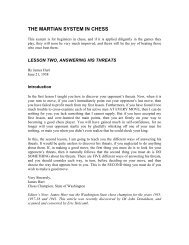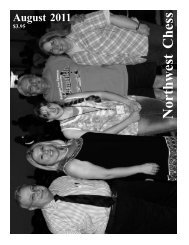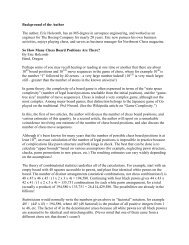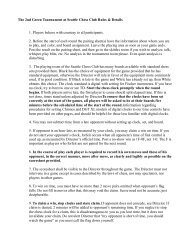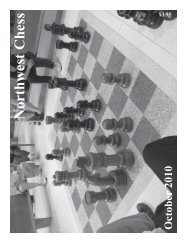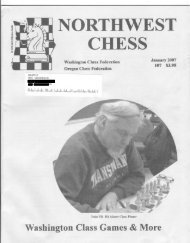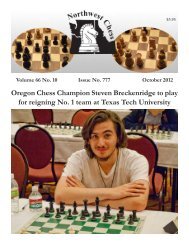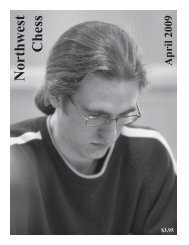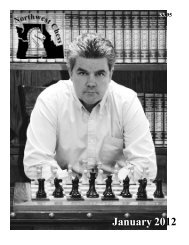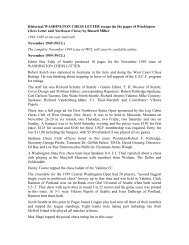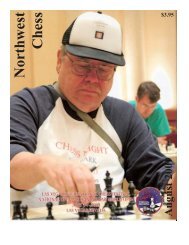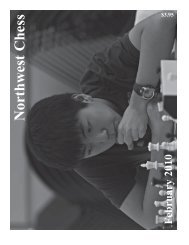April 2013 - Northwest Chess!
April 2013 - Northwest Chess!
April 2013 - Northwest Chess!
You also want an ePaper? Increase the reach of your titles
YUMPU automatically turns print PDFs into web optimized ePapers that Google loves.
<strong>Chess</strong> is considered to be a game<br />
of skill and not chance, and I would<br />
never dispute that, but the fact<br />
remains that sometimes a little luck<br />
creeps into the equation. How else<br />
to explain the situation when an<br />
opponent stumbles into a line you<br />
haven’t prepared for them but just<br />
happened to have studied recently.<br />
Ditto when they fall headlong into a<br />
well-known trap.<br />
During the weekend of the recent<br />
David Collyer Memorial in Spokane I<br />
was twice the recipient of such good<br />
fortune. The first occurred in a simul<br />
I gave the evening before.<br />
1.e4 e5 2.Nf3 Nc6 3.Bb5 d6 4.d4<br />
Nf6 5.Nc3 Bd7 6.0–0 Be7 7.Re1<br />
Luck in <strong>Chess</strong><br />
by IM John Donaldson<br />
Raxd8 11.Nxe5 Bxe4 12.Nxe4<br />
Nxe4 13.Nd3 f5 14.f3 Bc5+<br />
15.Nxc5!<br />
White sidesteps 15.Kh1 Nf2+ and<br />
15.Kf1 Bb6 which allow Black to<br />
escape.<br />
15...Nxc5 16.Bg5<br />
White wins the exchange and the<br />
game.<br />
If that felt like good fortune after<br />
the following game from round two<br />
of the Collyer I felt that Caissa must<br />
really be shining on me.<br />
Not just amateur players have<br />
forgotten that 7...Qa5 forces White<br />
to castle kingside.<br />
One recent example is 9.Bd3 (Or<br />
9.Nd2 Qxb2 10.Nb5 Qe5 11.f4 Qb8<br />
12.e5 Nxe5! 13.fxe5 Qxe5 14.Kf2<br />
a6 15.Nd4 b5 16.Bb3 Bh6 17.Bxh6<br />
Qxd4+ 18.Kf1 Ng4 19.Bxf7+<br />
Kxf7 20.Qf3+ Qf6 winning) 9...<br />
Nxe4 10.Bxe4 Bxc3+ 11.bxc3 Qxe4<br />
and Black was a solid pawn up in<br />
Nakamura-Ljubojevic, Amsterdam<br />
2009. Note that 8.Qd2 Nxe4! 9.Nxc6<br />
Qxc3! also leaves Black a pawn ahead.<br />
8...Qb4 9.Bb3<br />
White could have bailed out with<br />
9.Nxc6 and avoided material loss.<br />
9...Nxe4 10.Nxc6 Bxc3+ 11.bxc3<br />
Qxc3+ 12.Ke2 dxc6<br />
Black blundered with<br />
7...0–0<br />
7...exd4 is forced and has been known<br />
since Tarrasch-Marco, Germany<br />
1892, but that hasn’t stopped over<br />
two dozen Masters and Experts<br />
from falling into the following trap<br />
in the subsequent 120 years. What<br />
follows explains why 3...a6 4.Ba4<br />
d6, which enables Black to hold his<br />
e5 strongpoint, is decidedly more<br />
popular today than 3...d6 today.<br />
8.Bxc6 Bxc6 9.dxe5 dxe5 10.Qxd8<br />
1.e4 c5 2.Nf3 Nc6 3.d4 cxd4<br />
4.Nxd4 g6 5.Nc3 Bg7 6.Be3 Nf6<br />
7.Bc4 Qa5<br />
This variation has a very specific<br />
point – to avoid the Yugoslav Attack<br />
where White castles queenside and<br />
throws his kingside pawns forward<br />
with abandon. The drawback of this<br />
older line is that Black’s queen can be<br />
become slightly misplaced.<br />
8.f3<br />
This misses the point as does 8.Nb3<br />
Qb4.<br />
[See the following analysis diagram]<br />
13.Re1<br />
Black’s last move made the capture<br />
<strong>Northwest</strong> <strong>Chess</strong> <strong>April</strong> <strong>2013</strong> Page 7



